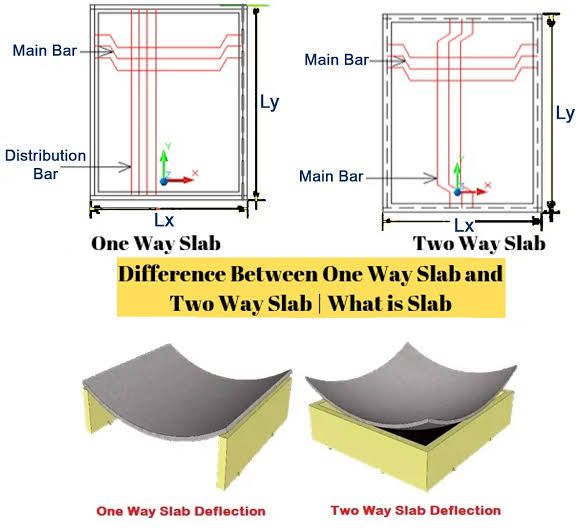Design of Reinforced Concrete Slab
Theory

One-way Slab:
- One-way slabs are structural elements commonly used in building construction to support loads primarily in one direction, usually spanning between beams or walls.
- The design of one-way slabs involves determining the slab thickness, reinforcement layout, and other parameters to ensure the slab can safely carry anticipated loads without exceeding allowable deflections or stresses.
- The design process typically begins with determining the design loads including dead load, live load, and other applicable loads as per relevant building codes and standards.
- Bending moments and shear forces are then calculated based on the applied loads and slab geometry. These are essential for sizing the slab thickness and selecting appropriate reinforcement.
- Reinforcement in one-way slabs is primarily provided in the form of reinforcing bars (rebars) placed in the tension zone to resist bending moments. The amount and spacing of reinforcement are determined based on the calculated bending moments and applicable design codes.
- Shear reinforcement may also be necessary to resist shear forces, especially near supports or openings.
- After determining the reinforcement layout, it is essential to check the deflection criteria to ensure serviceability requirements are met.
- The design is then validated through structural analysis, either using software tools like ETABS, SAP2000, or manual calculations following established design procedures.
Two-way Slab:
- A rectangular slab supported on four sides, and experiencing two-way bending where transverse loads span in both directions, perpendicular to all supporting edges. The load is distributed evenly, resembling a dish or saucer, transferring the load to the supports and deflecting in both directions.
- Deflection Profile: In the case of a two-way slab, the deflection profile resembles that of a dish or saucer, as observed from the slab behaviour described above. The deflection contours are obtained from these surfaces. These contours display varying shapes, closely spaced in certain areas, indicating steeper curvature in the shorter direction due to the concentration of bending moments, while being more widely spaced in the longer direction. This observation simplifies that larger moments lead to proportional curvatures, resulting in a more pronounced variation of slopes along the shorter span direction compared to the longer span direction. Therefore, provisions for main steel reinforcement are necessary in both directions to accommodate bending moments of comparable magnitude. The determination of bending moments Mx and My in two directions have been elaborated in the analysis of two-way bending moments.

